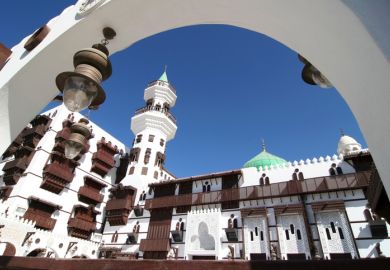Browse the full results of the Arab University Rankings 2022
Several countries in the Arab world have experienced rapid improvement in higher education in recent years – this progress is part of the reason Times Higher Education launched a specific ranking for the area last year – but as a region it is far from homogeneous.
With their very different histories, political systems and economies, the region’s countries will inevitably have different strengths in higher education.
As THE’s data rank universities by how they perform on measures of teaching, research, international outlook and impact on society, we are able to ascertain where those strengths lie. Here we explore which countries dominate the rankings and why.
United Arab Emirates
Among countries with at least five universities ranked, the United Arab Emirates (UAE) recorded the highest average overall score for its institutions, at 71.2.
It had a total of nine universities ranked, and three of them were among the top 10 – Khalifa University (fifth), United Arab Emirates University (joint seventh) and the University of Sharjah (ninth).
The UAE performs particularly strongly in the international outlook category, which measures the proportion of international students, the proportion of international staff, international co-authorship and collaboration within the Arab world.
Its average score for the proportion of international staff in the country is almost 100 – the country’s highest average score overall on a particular metric – and one of its institutions, the American University of Ras Al Khaimah, topped the table for international outlook.
This internationalist outlook is one of the reasons why the UAE has a higher overall score than Lebanon (69.8), Saudi Arabia (59.3) and Egypt (59.6). It performed less well on the society and teaching measures, however, with a particularly low score in the proportion of doctorates awarded to academic staff.
In recent years, the UAE has become a popular holiday destination, but Manar Sabry, senior assistant director for strategic analysis at SUNY Binghamton University, does not think this has had a significant effect on its attractiveness to international students.
Instead, she believes, they are being drawn by a number of factors – namely the quality of education, the fields of study on offer, and the cost of a degree.
That they can find everything they are looking for in a place where they can also have fun – and sun – is merely a bonus, she said.
Beyond the weather, the UAE is making efforts to attract talent, with a number of policies in place, including a five-year visa for outstanding international students.
“The UAE has invested heavily in education and higher education for several decades, which helped with attracting world-class universities to open branches and/or partner with them,” Sabry says. “The country attracts students from a variety of backgrounds, many from Arab countries and Asian countries. Its proximity to many destination countries and the relatively lower cost of living contribute to the increasing number of international students.”
It is a safe country politically and welcoming to foreigners, who in turn no longer send their children back to their native country to study thanks to the wide variety of universities close at hand, she added.
This is just one of a number of “significant advantages” the UAE enjoys over neighbouring rivals such as Saudi Arabia, according to Christopher Davidson, a fellow of the European Centre for International Affairs.
“It recognised the need for investment much earlier and saw higher education as a major component of its effort to diversify its economy away from oil and gas,” he says.
“The UAE is the furthest down that road in diversifying its economy away from coal and oil. They recognised in particular that one of the ways for a wealthy Gulf state with a small population to diversify from oil was by boosting its so-called knowledge economy.”
The widespread use of English in the UAE is another reason why it does so well in THE’s rankings, according to Davidson.
He says the country is “far more cosmopolitan and foreigner-friendly” than neighbouring Saudi Arabia, which allows it to attract both international faculty and students.
“English is effectively the language of the UAE, with every citizen essentially bilingual, so it’s much further down that road than Saudi Arabia,” he adds.
“It has a more international-feeling society, which has been conducive for attracting the right sort of talent.”
Saudi Arabia
Saudi Arabia is certainly not falling short when it comes to the Arab ranking, however.
The country’s institutions occupy five of the top 10 spots on the list, with King Abdulaziz University triumphing over more than 150 other universities from across the region to claim the crown – just as it did in last year’s inaugural rankings.
It is followed by King Abdullah University of Science and Technology (placing second), Prince Mohammad Bin Fahd University (fourth), King Fahd University of Petroleum and Minerals (sixth) and King Saud University (joint seventh) – among a total of 32 Saudi universities in the rankings.

King Abdulaziz University tops the tables for both the teaching and society metrics. King Abdullah University of Science and Technology just pips King Saud University to first position in the research category, alongside. On the citations measure, Prince Sultan University comes out on top. All that means Saudi Arabian universities claim first spot in four of the five rankings pillars.
The country recorded its highest average scores on the citation and international outlook pillars.
Its lowest marks came in teaching, including a score of just 37.5 for doctorates awarded to academic staff.
Muhammad Asad, assistant to the vice-president on ranking at Prince Mohammad Bin Fahd University, explains why Saudi universities have performed so well in the league table.
They are adopting new trends in teaching and learning, investing in applied research projects, engaging with industries and partnerships involving world-renowned institutions, and following sustainable practices, he says.
To improve its showing in the society category next year, Asad encourages his country’s universities to increase their engagement with local and international industry. Meanwhile, Saudi Arabia can boost its performance in the research and international outlook arenas by hosting and participating in more international conferences, and by expanding its international research collaboration, he says.
According to Davidson, Saudi Arabia is aiming to be more like the UAE, “to have a more international faculty and more international students – and I don’t doubt they will get there, but they are starting from quite a number of years behind the UAE”.
Before King Salman’s succession in early 2015, Saudi Arabia had invested heavily in sending its talented youth abroad on scholarship programmes, while the domestic higher education sector “perhaps did not receive the investment and attention it needed”, says Davidson.
He adds: “Since then, there’s no doubt Saudi Arabia continues to finance heavily these programmes, but it also seems to have matched that with a genuine attention and investment in its higher education sector.”
Despite a lower average overall score than the UAE, Saudi Arabia is “in many ways the really big success story of the last few years”, Davidson argues.
“It’s operating far more HEIs than the UAE and is one of the biggest higher education providers in the Arab world now,” he says.
The success of Saudi Arabia and the UAE was evident in THE’s World University Rankings 2023, where the two countries raised their overall scores at a faster rate than the global average.
Lebanon
There are many similarities between the UAE and Saudi Arabia, but Lebanon is a different story. Yet despite living through an ongoing economic crisis that the World Bank has called one of the worst in more than a century, Lebanon’s universities scored second best overall in the Arab rankings.
They did particularly well in the teaching category, notching up a very high average score for teaching reputation and for the proportion of doctorates awarded to undergraduates.

This strong showing on teaching came despite a poor performance in the subcategory of institutional income to academic staff, attesting perhaps to the dedication of Lebanese academics.
The top performing of Lebanon’s five ranked universities were the Beirut Arab University (11th) and the American University of Beirut (13th). The Lebanese University also scored highly for teaching (79).
Egypt
With 34 universities featured in the rankings, Egypt is the best represented of all 15 Arab countries, and it had more institutions among the top 50 than Saudi Arabia, which has a similar number of universities overall.
Zewail City of Science and Technology – the country’s top performer – cracked the top 10, placing 10th overall.
The country did well on citations, scoring 71.3, its highest average score in the main pillars. That was helped, no doubt, by near-perfect performances for citations at Kafrelsheikh University and Suez University.
However, the country fared less well in the international outlook category – scoring just 45.3.
The presence of Lebanon and Egypt so high in the table overall is a testament to their “long history and legacy of higher education in the Arab world”, Davidson says.
“Beirut and Cairo are the historic centres of Arab knowledge production, with a strong higher education teaching and research pedigree.
“Lebanon – despite all its economic problems – is a remarkable story of resilience. I think the same could be said for Egypt as well, which in the space of the last 12 years has had a revolution, a military coup d’état and widespread economic problems. But across its 34 higher education institutions they are scoring pretty well – better, for example, than relatively stable countries like Tunisia and Morocco.”
Areas for attention
Looking at the results more broadly across all the 169 ranked universities, higher education in the region performed best on the society pillar and was weakest when it came to research.
There was lots of variation across the citation pillar, with a huge gulf between the top score (at Prince Sultan University in Saudi Arabia) and the bottom score (at the University of Science and Technology of Oran Mohamed-Boudiaf in Algeria).
Given the English language barrier in many of the region’s countries, it is not surprising that the citation score is the most inconsistent, says Davidson.
However, he continues, citations are one area likely to see rapid improvement in the coming years – particularly in Saudi Arabia.
Leading universities in the Western world are typically viewed as part of a research academy, says Davidson.
“What’s traditionally been the case in the Arab world is that higher education institutions have been very closely tied to what the job market and broader society expects of them. In the Arab world, graduates are usually trained for the labour market or a particular part of society.”
Sabry says there could be many reasons behind such inconsistency, including the impact of Covid-19, when priorities shifted to support research related to the pandemic and vaccines, which left Arab countries lagging behind in other areas.
“The economic effect of Covid also negatively affected the funding of other research fields, and we are still feeling such effects. This may have caused the inconsistent results of citation scores, and we can expect to see the same next year as well,” she says.
Given so many differences between the countries in terms of their results, each of them should look at its situation individually to make improvements, she argues.
“I think those with the lowest ranking should prioritise teaching and research, but those in higher positions need to work on citations and society,” she says.
There are 169 universities in this year’s Arab rankings, across 15 countries. The ranking is based on THE’s World University Rankings but adapts the methodology slightly to suit the unique region.
According to Davidson, the THE rankings provide a “much-needed signal” to the nations performing well that they have made the right decisions and investment choices in recent years.
POSTSCRIPT:
Print headline: Power points
Register to continue
Why register?
- Registration is free and only takes a moment
- Once registered, you can read 3 articles a month
- Sign up for our newsletter
Subscribe
Or subscribe for unlimited access to:
- Unlimited access to news, views, insights & reviews
- Digital editions
- Digital access to THE’s university and college rankings analysis
Already registered or a current subscriber?




